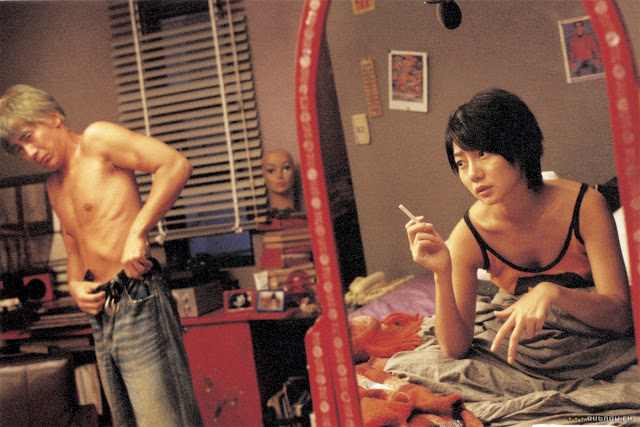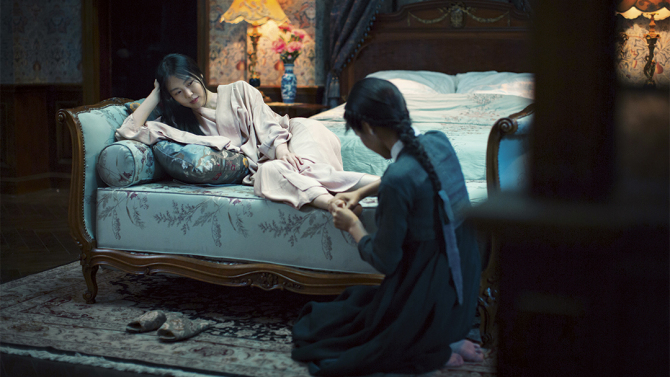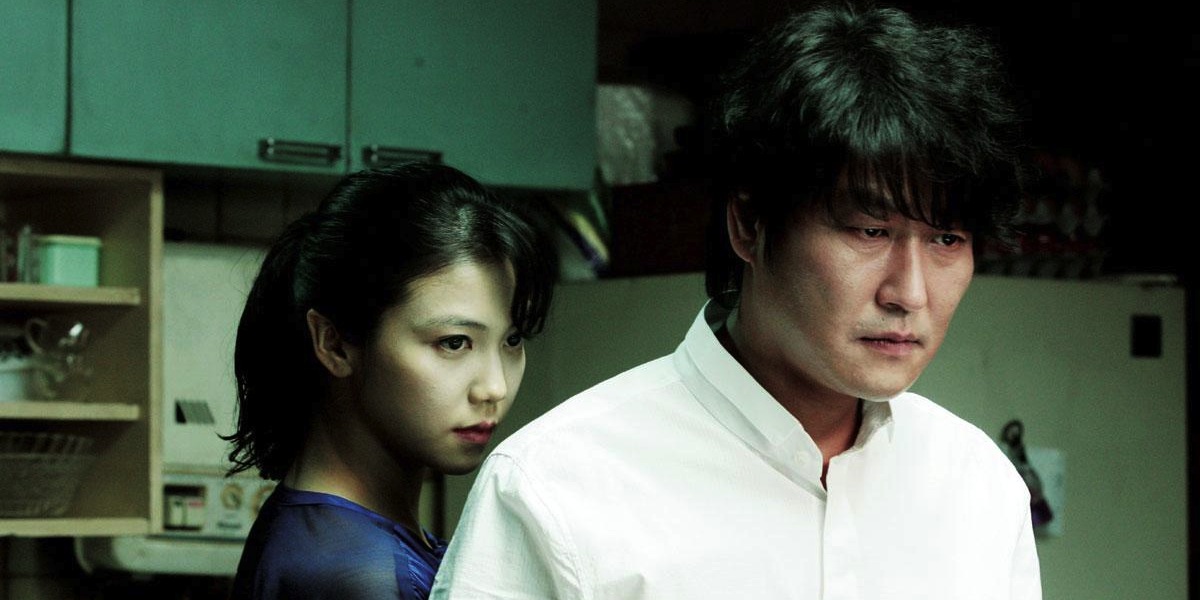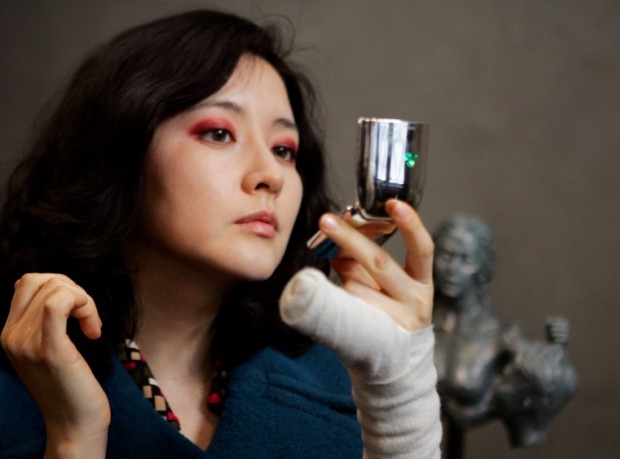5. Sympathy for Mr. Vengeance (2002)

The first part of the “Vengeance Trilogy” revolves around Ryu, a deaf-mute who works in a factory while he also has to take care of his sick sister, who is in desperate need of a kidney transplant.
His situation takes a turn for the even worse when the doctors inform him that he is not a suitable donor and at the same time, he is fired from his job. Utterly desperate, he decides to search in the black market for a kidney, and although he manages to find some people who can help him, they prove to be con men who eventually take all of his compensation and one of his own kidneys, and leave him injured and naked in an unknown building. Seeing Ryu in this situation, his anarchist girlfriend, Yeong-mi, suggests kidnapping the daughter of his boss, Dong-jin, who has laid off many workers from his factory.
Park presented the extremes an individual can reach when they find themselves in desperate situations. Revenge, the central theme of the film, results from the aforementioned situations and is presented in four axes. Ryu wants to exact revenge from those who tricked him. Yeong-mi wants to exact revenge from the ‘Capital’.
Dong-jin wants to exact revenge from those who kidnapped his daughter. Yeong-min’s fellow terrorists want to exact revenge for their comrade. In this fashion, Park wanted to present the futility of revenge, as all of the aforementioned succeed in their purpose but gain nothing from it.
Shin Ha-kyun as Ryu, Bae Doona as Cha Yeong-mi and Song Kang-ho as Dong-jin are all magnificent in their respective parts. Particularly the first two have very difficult parts, since Ha-kyun does not speak at all and Doona had to speak and to use sign language at the same time; however, they delivered to the fullest.
4. The Handmaiden (2016)

“The Handmaiden” proves that Park Chan-wook is one of the top filmmakers of this era, and that the knowledge he acquired from his time in Hollywood can be wonderfully implemented in Asian aesthetics.
The script is based on the novel “Fingersmith” by Sarah Waters and takes place in 1930’s Korea, with the country under Japanese rule. Con man “Count” Fujiwara has managed to insert himself into the very secluded circle of Kouzuki, an eccentric hedonist who has become the man in charge of a very large estate, and plans to marry his niece, Lady Hideko, the actual heiress of the family’s vast fortune.
Fujiwara devices an intricate plan to “steal” Lady Hideko for himself, and asks the help of a ragtag girl, Sook-hee, a petty criminal who lives with her aunt’s family, all of whom are of the same ‘profession’. The plan is for the girl to become Lady Hideko’s handmaiden, and to help Fujiwara seduce her. However, things do not go as planned, since an attraction is formed between the two girls, and the many plot twists result in a much-unexpected story.
Park stayed close to the structure of the book, which is split into three segments, with the first and the third segments telling the story from Sook-hee’s perspective, and the second one from Lady Hideko’s. In that fashion, he used much narration, which is presented as the thoughts of the person that tells the story each time, and actually helps greatly in the understanding of the script.
However, his usual traits are once more present. The characters act like caricatures, as exemplified by Sook-hee and particularly Kouzuki in perverse style. His irony, exemplified by the fact that the house combines Japanese and European-style architecture, in a hideous manufacture that mocks the fact that rich people can do whatever they have in their minds, but that does not mean they also have taste.
His dark and grotesque humor is also featured, which is exemplified in a torture scene where the victim seems to even indulge in his maiming. The abnormal eroticism is also exemplified in the concept of the underground erotic literature club.
3. Thirst (2009)

Park Chan-wook’s take on the vampire is another magnificent film, which manages to combine the myth with themes on Christianity, through Park’s unique point of view.
Sang-hyun is a well-respected Christian priest, cherished in his community for his kindness and faith. To justify this sentiment even more, Sang-hyun spends much of his spare time at a local hospital, offering guidance and blessings to patients.
However, his interaction with many patients who eventually die have made him depressed, to the point that he eventually decides to assist a group of scientists experimenting on a vaccine for an incurable, deadly virus. During a test, the virus affects Sang-hyun, and the scientists decide to help him with a blood transfusion.
The virus retreats and the priest becomes an object of even more admiration as the faithful consider his case a miracle. Among the people who visit him to pay their respects is his childhood friend, Kang-woo, who invites him to his house where he lives with his wife, Tae-ju, and his bossy mother, Lady Ra. Sang-hyun feels an immediate attraction to Tae-ju, and as he is transforming into a vampire, the feelings become mutual, forcing him to act, on both cases, against everything he believes in.
Park focuses the film around two contradictory axes: the sense of guilt, which is so common among Catholics, and the feeling of desire. Both of these axes are implemented though Sang-hyun, who is faithful enough to face death and to serve people to his fullest, but on the other hand, cannot resist his desire for the beautiful and miserable Tae-ju. He cannot stop his flock from considering his vampirism as a sign of Divine Grace and the same time, he is drowning in guilt due to his sins.
2. Lady Vengeance (2005)

The third part of the “Vengeance Trilogy” presents the theme of revenge from a female point of view.
The script revolves around Geum-ja, a woman found guilty for the kidnapping and murder of a child, who has waited patiently in prison for 13 years in order to avenge the man responsible for most of the evils in her life. While there, she managed to present an utterly benevolent persona, whose sole purpose was to make the friends needed for the intricate plan she has conceived. After her release, she exploits those acquaintances, but as she is about to fulfill her purpose, she realizes that the truth is much worse than she imagined.
Park focused on a female character this time, and created a unique amalgam of black humor; blasphemous irony; extreme violence, which at times, is turned on children; and liberating humanism, chiefly depicted in the final sequence of collective revenge.
The fact that ordinary people can turn into sadistic murderers presents Park’s message regarding revenge: sometimes, vengeance through violence is the only way to true catharsis. In order to justify this philosophy, he paints the evil character with the most gruesome colors, to a point that any action against him is deemed worthy, and even fair.
Lee Young-ae is spectacular in the titular character, with the overwhelming majority of the film being based upon her. Her transformation from a victim, to a “saint,” to a vigilante, and finally to an ordinary (of sorts) woman is probably the film’s greatest asset. Choi Min-sik is, once more, quite persuasive as the embodiment of pure evil, although his part is quite small. He certainly deserves an award for the things Park made his characters go through in the last two films of the trilogy.
1. Oldboy (2003)

This second installment of Park Chan-wook’s “Vengeance Trilogy” is the film that turned the global interest toward Korean cinema.
Based on the homonymous Japanese manga, the film focuses on Dae-su, a businessman who is arrested for drunkenness, missing his daughter’s fourth birthday.
The same night, and for no apparent reason, he is abducted and forced to live in the same room for 15 years. When he is unexpectedly released, he is set on exacting revenge, although the sole evidence in his possession is the fact that he must accomplish this revenge in five days. A girl he meets at a sushi restaurant, where she works as a chef, decides to help him, once more with no apparent reason.
Although “Oldboy” has revenge as its central theme, Park directs a movie with the actual goal of presenting another dimension, one that leads to repentance. The humiliation and ensuing catharsis are the primary concepts, and revenge, which creates chain reactions of growing hatred, is solely an element of the set, with the focus being on vengeance not as an act, but rather the reasons that lead to it and its consequences.
Choi Min-sik is sublime as Dae-su, giving a magnificent performance and artfully presenting a plethora of sentiments that vary from ecstasy to paranoia, while retaining a style that makes him seem, at most times, as a caricature. Yoo Ji-tae is also great as the impersonation of evil and Kang Hye-du is quite functional as the girl who falls in love with Dae-su. Kim Byeong-ok as Mr. Han is a nice addition to the film, in cult fashion.
Author Bio: Panos Kotzathanasis is a film critic who focuses on the cinema of East Asia. He enjoys films from all genres, although he is a big fan of exploitation. You can follow him on Facebook or Twitter.